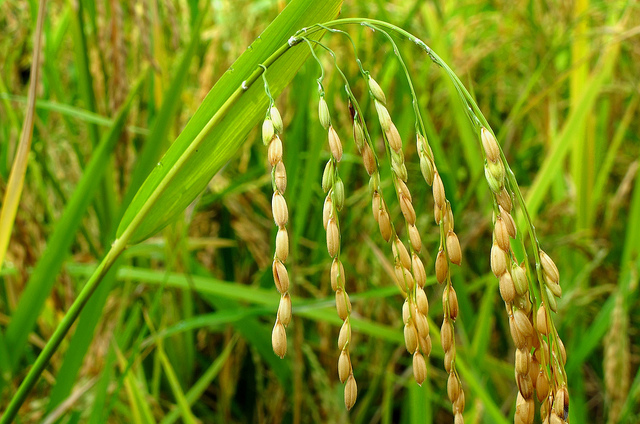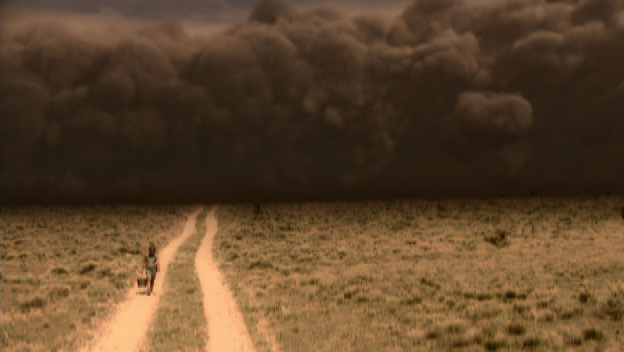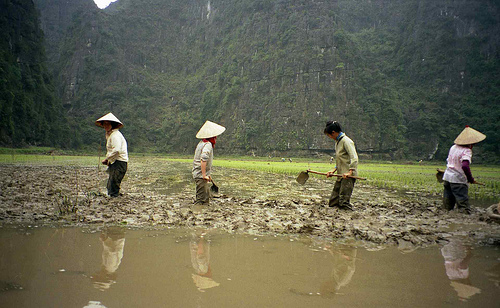In his new survey of Vietnamese history, Ben Kiernan attempts to include information on environmental history.
As part of that effort, he has a section on “Climate Change and Economic Growth in the Eleventh and Twelfth Centuries.” This section is based on his reading of an English translation that he had someone make based on the Vietnamese translation of the Việt sử lược 越史略 (Outline of Việt History), a fourteenth-century text that was written in classical Chinese.
In other words, Kiernan’s understanding of climate change and economic growth in Vietnam in the eleventh and twelfth centuries is based on a translation of a translation.
Let’s take a look at how that went.

This is what Kiernan writes:
“From the late tenth century, VSL’s [i.e., the Việt sử lược] author begins occasionally reporting climatic and agricultural conditions in Đại Việt. The scattered records, consistent with the tree-ring data [I still need to find where in this book he talks about this tree ring data], suggest that rainfall and rice harvests were increasing over the eleventh and twelfth centuries. A ‘big flood’ came in 997 and ‘bumper crops’ in 1016. In 1029 ‘it rained hard with rice from the sky, heaping on the courtyard’ of Vạn Tuế pagoda. Farmers brought in a ‘big crop’ in 1044.
“In 1071 there was ‘no rain from the spring to the summer,’ but the next year was too wet: ‘The king sent people to bring a Buddha statue from Pháp Vân pagoda to the capital [in order] to pray for dry weather.’ In 1078, ‘the citadel was flooded.’ A hailstorm struck the following year, and that May ‘we harvested a great crop.’ The year 1092 saw another excellent harvest. The spring of 1102 brought ‘virtuous clouds descending,’ followed by a flood, and the next spring ‘the king ordered people from all over the citadel to participate in the building of dikes to block flood waters.’
“Considered a good omen, ‘sweet water rainfall’ was recorded in 1080, 1112, and 1118, and once again, ‘good clouds descended’ in 1114.
“Consistent with wetter conditions, better harvests, and population growth came the records of ‘huge epidemics,’ which occurred in 1100 and 1105.
“VSL [i.e., the Việt sử lược] reports six ‘droughts’ between 1124 and 1148, but in five of those cases, royally sponsored ‘prayer sessions’ succeeded in bringing rains.” (pgs. 148-149)

So according to Kiernan, in the eleventh and twelfth centuries we can see a lot of rain and a lot of good harvests. Yes, there were some droughts, but apparently monarchs were able to successfully pray for rain. Hence, Kiernan’s use of scare quotes around the term “droughts.”
As a result, the population grew, and that led to the unfortunate side effect of the outbreak of occasional epidemics.
Ok, so let’s now take a look at what is actually recorded in the Việt sử lược. And let’s start with some of the terms that Kiernan mentions.
He says that in 1029 ‘it rained hard with rice from the sky, heaping on the courtyard’ of Vạn Tuế pagoda. What exactly does that mean?
The Việt sử lược records that “In winter, in the tenth lunar month, in front of Vạn Tuế Pagoda it rained white rice that formed piles” (冬十月,萬歲寺前雨白米成堆。)
The tenth lunar month is the equivalent of November. What looks like white rice and can form a pile? Some form of snow, or sleet, perhaps?
And what is “sweet water rainfall”? The term that is used in the Việt sử lược is cam lộ 甘露, which can mean either “sweet dew” or “sweet frost.” As can be seen below, most of the instances in which this phenomenon was recorded were during winter months. As such, rather than “sweet water rainfall,” this term should be understood as “sweet frost.”
[UPDATE: A reader pointed out to me that cam lộ 甘露 is a Buddhist term (“sweet dew”) and is associated with Quan Âm/Guanyin. It totally makes sense that the court would seek to explain an anomaly in positive terms using a Buddhist term. What, however, was the anomaly? Given that frost is common in northern Vietnam, I would argue that this must be referring to something like a light snow, or what is sometimes termed in English, “a dusting of snow.” At the very least it has to refer to some manifestation of dew that is different from the norm.]
Similarly, what are the “virtuous clouds descending” that Kiernan mentions? The expression that is used in the Việt sử lược is thụy tuyết giáng 瑞雪降, which means “auspicious snow descended.”
What was “auspicious” about snow and “sweet” about frost? It was that these anomalous phenomena were interpreted by the royal court at that time as positive signs, just as the efforts of monarchs to pray for rain were viewed as successful.
If, however, we peel away that interpretive layer and just look at the fact that these statements are referring to times when it was cold or when there was little rain, then a very different pattern from what Kiernan describes becomes immediately evident.

The Việt sử lược does indeed record that there were good harvests (đại thục 大熟) in the following years: 1016, 1030, 1044, 1079, 1092, 1111, 1123. However, those final good harvests occurred at a time when it is also clear that the climate was getting colder and more unstable in terms of rainfall.
This, for instance, is what the Việt sử lược records about the late eleventh and early twelfth centuries:
1078: 大水入城内。 “A flood entered the citadel.”
1079: 雨雹 It hailed. [The text doesn’t say when but the following entry is for the fifth lunar month, so it must be before that.]
1080: 秋八月,甘露降。 In autumn, during the eight lunar month [~September] a sweet frost descended.”
1100: 十二月,大疫。 “In the twelfth lunar month there was a major epidemic.”
1102: 冬十二月,立春,瑞雪降。 In winter, during the twelfth lunar month, at the beginning of spring [~early February], auspicious snow descended.”
1102: 大水。 “There was a great flood.”
1103: 春正月,詔京城内外皆筑堤捍水。 “In the first month of spring, people from inside and outside of the citadel were ordered to build dikes to hold back the waters.”
1105: 大疫。There was a major epidemic. [in the 11th lunar month]
1112: 春正月,甘露降。 “In the first month of spring, a sweet frost descended.”
1114: 春正月,瑞雪降。 “In the first month of spring, auspicious snow descended.”
1118: 冬十一月,甘露降。 “In winter, during the eleventh lunar month, a sweet frost descended.”
1121: 夏五月,大水至大興門。 “In summer, during the fifth lunar month, a great flood reached the Đại Hưng Gate.”

What the above records indicate is that it is not the case that epidemics occurred because “Consistent with wetter conditions, better harvests, and population growth came the records of ‘huge epidemics,’” but because the climate changed and people became cold (and probably hungry).
This period was then followed by a few decades of drier weather.
1124: 大旱,祷之,乃雨。 “A major drought. Prayers were made and it rained.”
1130: 六月,旱,祷而雨。 “In the sixth month there was a drought. There were prayers and it rained.”
1134: 自春至夏不雨。 “From the spring to the summer there was no rain.”
1140: 自春至夏不雨,王祷之,乃雨。 “From the spring to the summer there was no rain. The king prayed and it rained.”
1143: 夏滛雨,祷之,有驗。 “In the summer there were excessive rains. Prayers were made, and they were effective.”
1148: 夏旱,祷而雨。 “In the summer there was a drought. Prayers were made and it rained.”
1150: 五月,天雨黄沙。 “In the fifth lunar month there was a dust storm [literally, ‘the sky rained yellow sand’].”
1154: 春三月,天雨黄沙。 “In the third lunar month of spring there was a dust storm.”

While Kiernan seems to imply that the droughts in this period were not a big deal (“in five of those cases, royally sponsored ‘prayer sessions’ succeeded in bringing rains”), the fact that there were dust storms in the 1150s indicates that a dry climate really had an impact on the environment. What is more, the fact that no “good harvests” were recorded for this period, also suggests that this was definitely not a time of “better harvests” and “population growth.”
This dry period ultimately came to an end, and it appears that the late twelfth and early thirteenth centuries witnessed another cold spell, although not as severe as the one a century earlier.
1180: 孟秋,大水。 “In the first month of spring there was a major flood.”
1184: 雨黑水。 “It rained black water.” [I’m not sure what this is referring to.]
1194: 雨雹大如馬頭,死者甚眾。 “Hail fell that was a big as a horse’s head. Many people died.”
1195: 大疫 “There was a major epidemic.” [at some point after the 5th lunar month]
1208: 冬十月,大水。 “In winter, during the tenth lunar month, there was a major flood.”
1216: 三月,雨雹。 “In the third lunar month it hailed.”
1218: 七月,大水。 “In the seventh lunar month there was a major flood.”
1219: 春二月,丙辰,雨雹。 “In the second month of spring, in the morning, it hailed.”
1220: 季春,雨雹。 “In the last month of spring it hailed.”
1222: 九月,大水。 “In the ninth lunar month there was a great flood.”

What we can see from these records, is that contrary to Kiernan’s claim that this was a period of increasing rainfall and rice harvests, it was a period of fluctuation. It became colder in the late eleventh and early twelfth centuries. This was followed by a period of drier weather for a few decades that led to dust storms in the 1150s. Following that the climate appears to have cooled again, although not to the levels it reached in the late eleventh and early twelfth centuries.
What is also clear is that people’s lives were affected by these climatic fluctuations. When it got cold and wet, people died.
In conclusion, it is nice to see that Kiernan would like to know about the environmental history of Vietnam. However, given that he cannot read the sources for Vietnamese history, he has no ability to write about the environmental history of Vietnam.
That can only be accomplished by people who can read primary sources, rather than translations of translations.


This Post Has 2 Comments
Tree ring data might be from the work of Brendan Buckley et al, who’ve been publishing a lot on climate/tree rings in SEA (especially in relation to the “collapse” of Angkor.
http://www.ldeo.columbia.edu/user/bmb
I also wonder whether there was extreme natural / geologic / atmospheric activity that caused these extremes? A meteor strike, immense forest fire or a volcano thousands of miles away could produce this, and the local people would be at a loss to explain them.